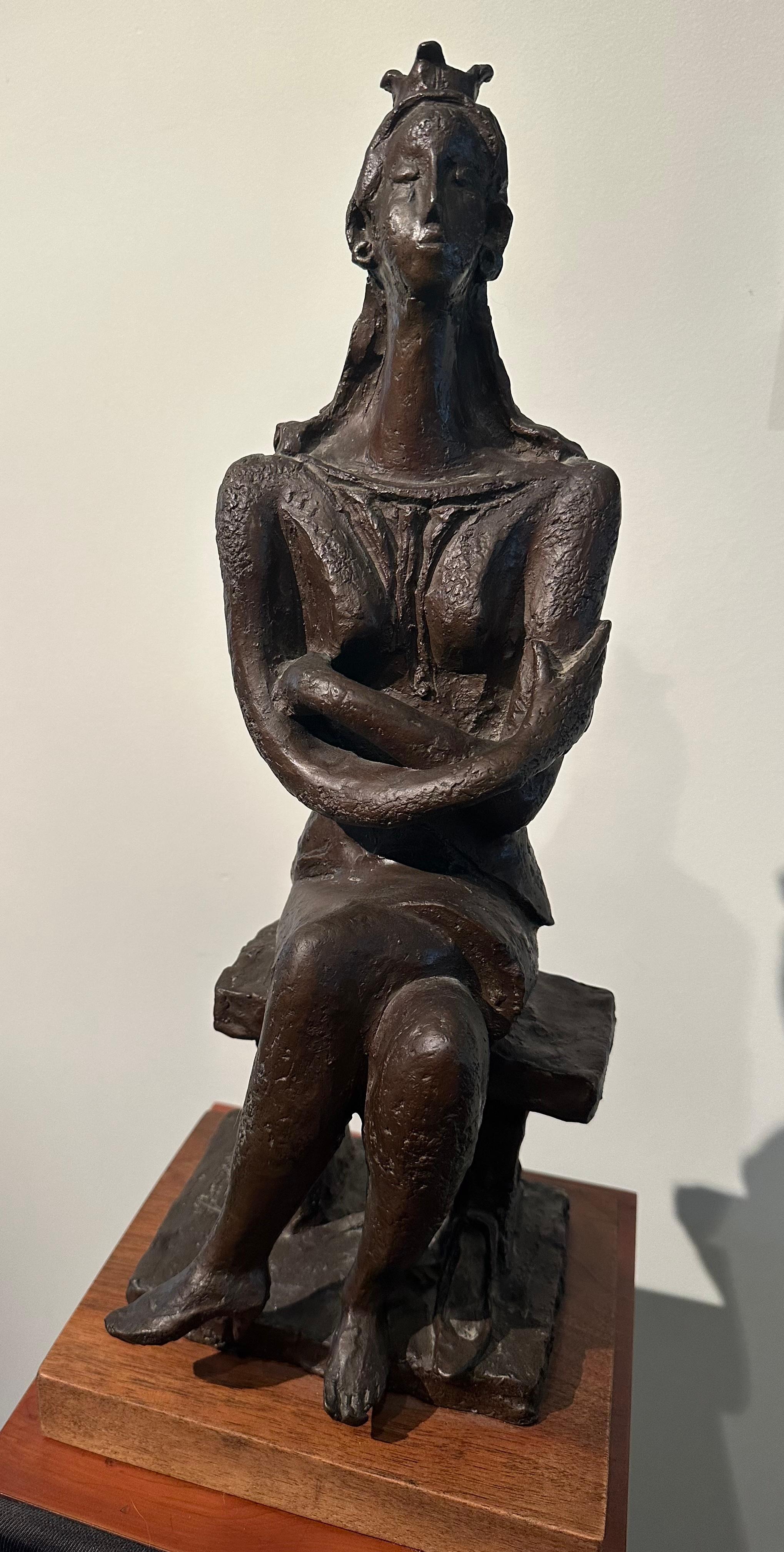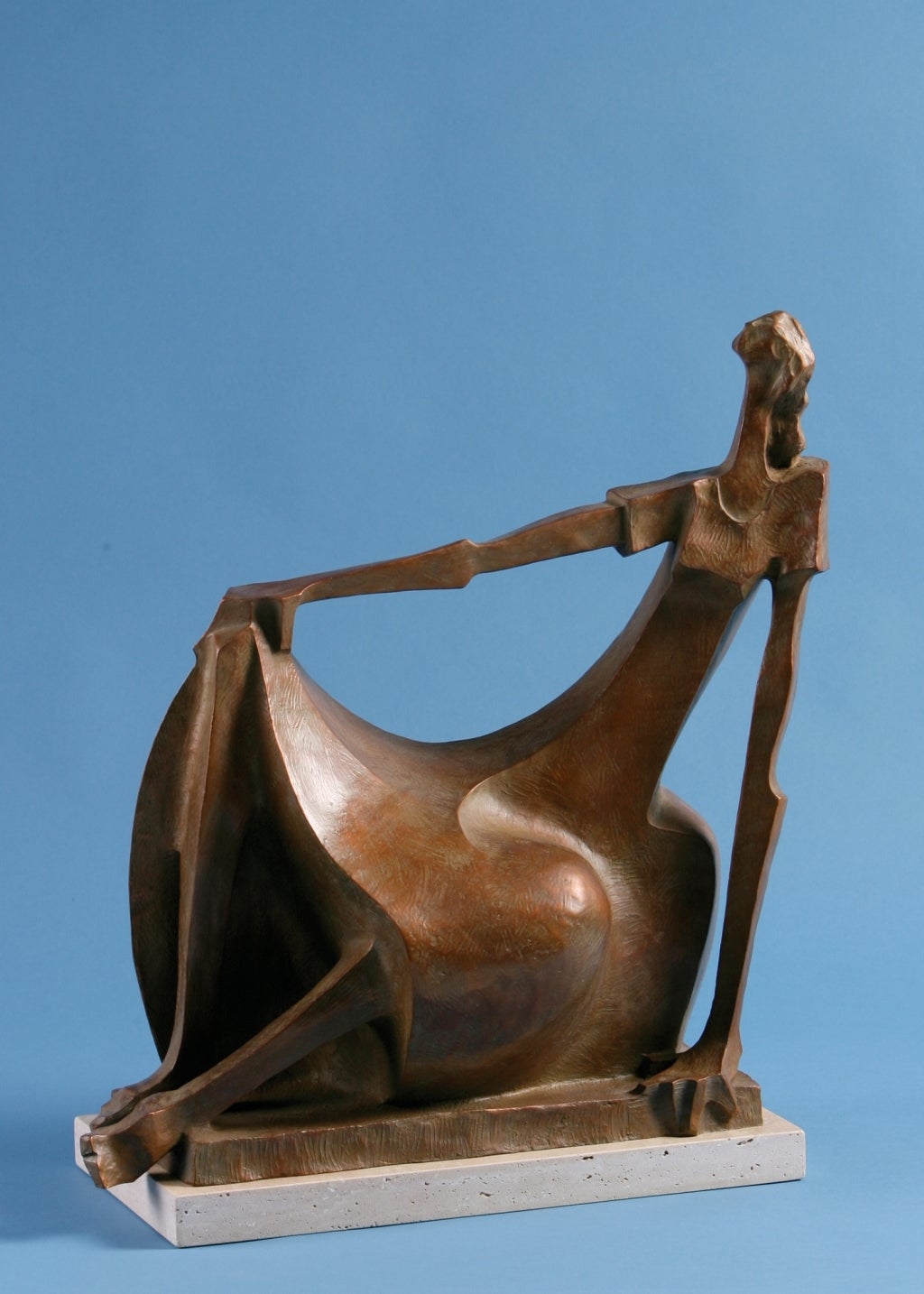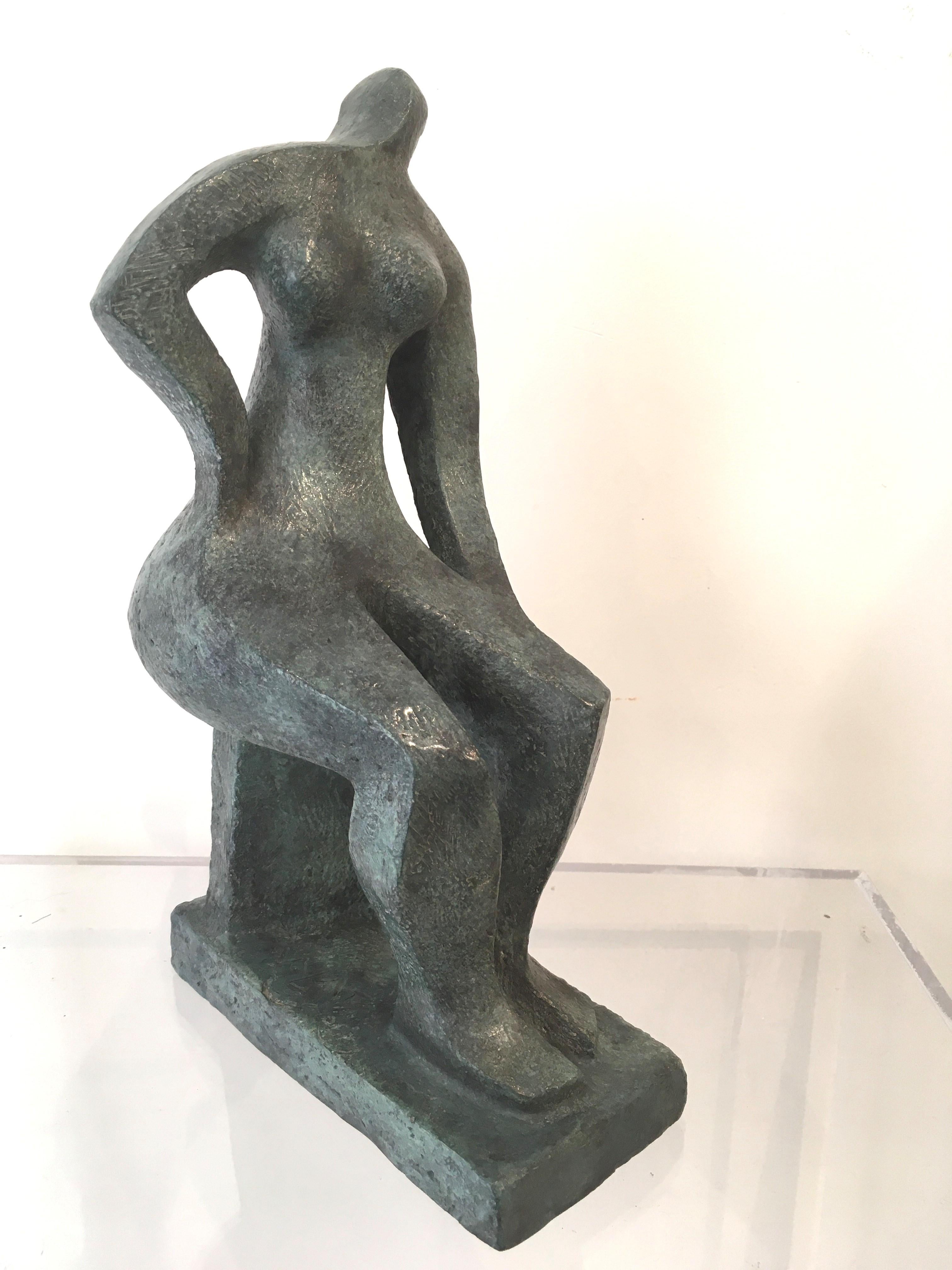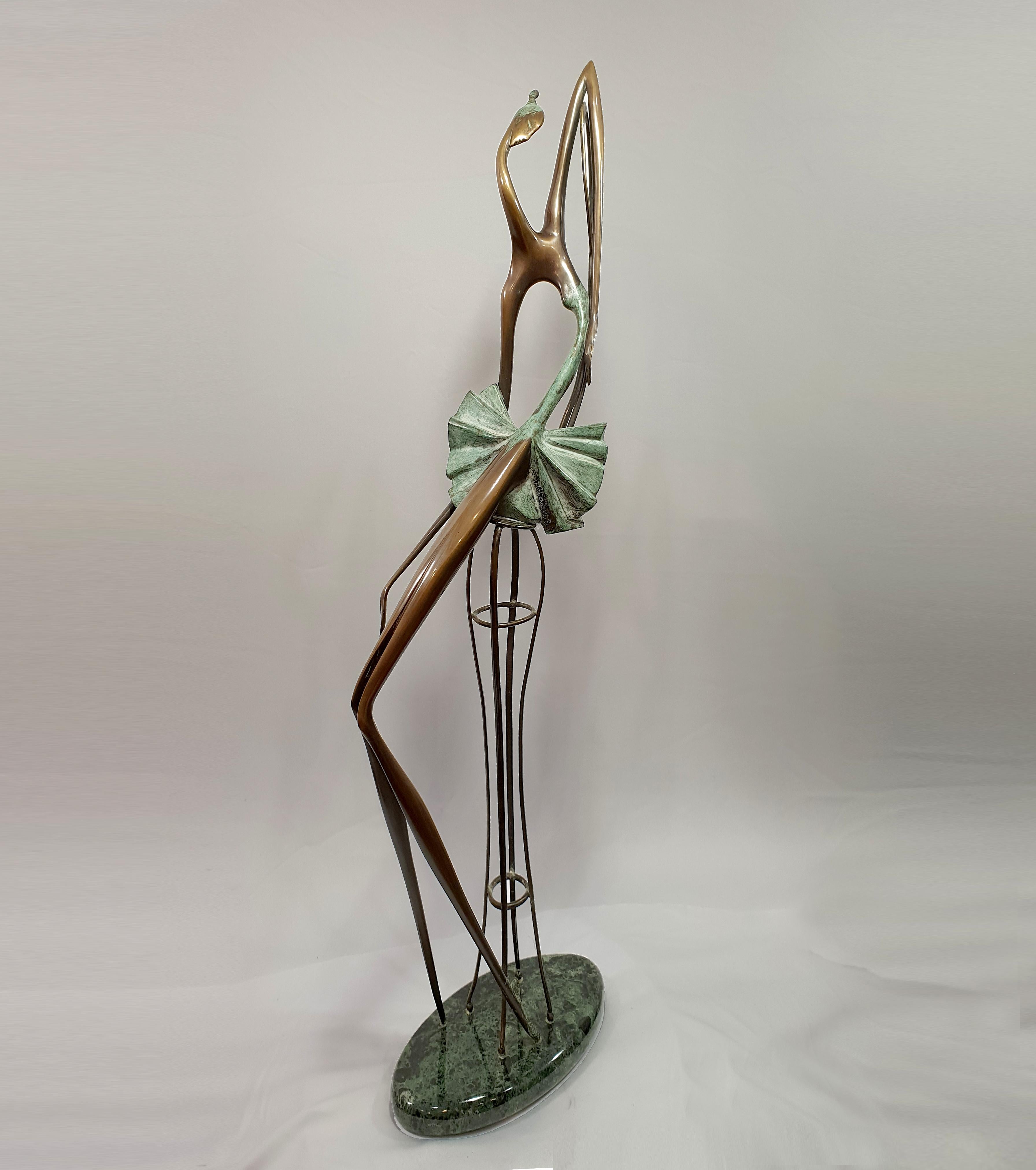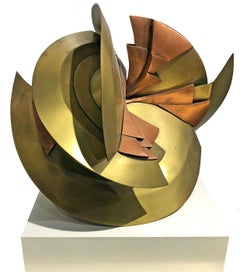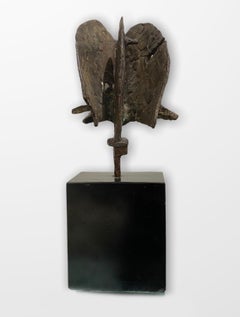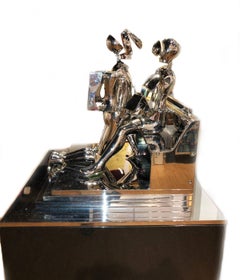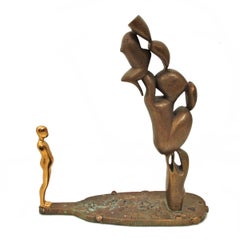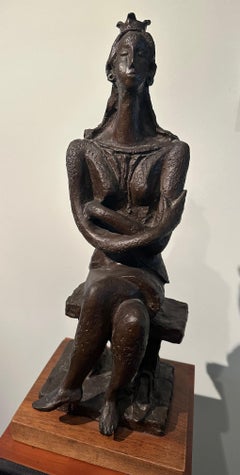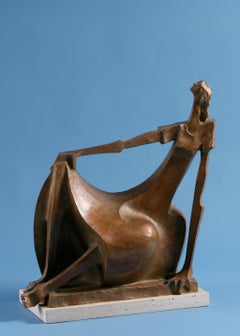Items Similar to Regina Enthroned
Want more images or videos?
Request additional images or videos from the seller
1 of 9
Lazzaro DonatiRegina Enthroned
Price Upon Request
Price Upon Request
Price Upon Request
Price Upon Request
Price Upon Request
Price Upon Request
Price Upon Request
Price Upon Request
Price Upon Request
Price Upon Request
About the Item
Lazzaro Donati (Italian 1926-1977)
"La Regina"
Bronze
Signed on Base
Size: approx 19 x 9 x 9 inches
Lazzaro Donati (1926-1977) was born in Florence in 1926 and attended the Academy of Fine Arts. He began to paint in 1953, and in 1955 held his first exhibition at the Indiano Gallery in Florence. Within three years eleven exhibitions followed in Italy, and as his reputation grew he was invited to give major exhibitions in London, Paris, New York, Chicago, Rio de Janeiro and Montevideo. He is considered one of the foremost contemporary Italian painters and his paintings hang in museums and private collections throughout the Americas, Europe and Asia.
Mr. Donati lived and worked at 24 Piazza Donatello in Florence, the square where generations of artists have created works worthy of the great Florentine tradition. As you entered the narrow hallway to his studio, a gilded life-size Venetian angel beckoned you to his door. Once inside, the present faded away and you found yourself in an atelier where early masters might have worked during the Renaissance. Within, luxurious Persian rugs set off the innumerable objects d'art and antique furnishings. Light poured in through the sloping glass wall on the north side. A dramatic stairway led to an overhanging balcony which served as a private gallery where the artist hung some of his favorite early works. To the left of the entrance was a smaller studio where Donati sculpted, with a window overlooking the famous old English cemetery where tourists laid flowers on the grave of Elizabeth Barrett Browning.
In the main studio itself, where Donati received his clients in an atmosphere as polished as an office of a top executive, one hardly realized that it was here that the artist actually painted. His easel was covered with Persian blue velvet, the painting on the easel was already framed, his chair was upholstered in red velvet and on his palette the colors were arranged with the precision of a Byzantine mosaic. In a corner stand were his latest works, framed and ready to be sent off to his next exhibition in Europe or America.
Donati was a born host with a warm welcome, an elegant man who possessed enormous charm a good nature and a keen sense of humor. Apparently shy, he preferred to speak on subjects extraneous to his art, purposely distracting you from his paintings, then leading you back to them, tactfully and without pretension. He spoke fluent French and English as well as some Spanish and German. "After all", he said, "you've got to know how to sell a painting to everyone."
He had no sympathy for the "drip and splash" studios of his contemporaries, preferring to keep his studio tidy and spotless. "Painting is a matter of precision", he said, "If a painter can't put his paint where he wants it to go, I don't see how he can call himself a painter. For me it is absolutely necessary to control the paint."
When asked to reveal the technique he used to achieve the enamel-like finish typical of his paintings he answered, "That is a secret between me and my butler. Actually, most of my paintings are done by him!"
But in fact behind the façade, Donati was a serious craftsman who devoted to his painting as a way of life and means of expression. From the beginning of his career, his paintings revealed a striving for perfection and continual research in problems of style and technique. His early works indicated a momentary interest in surrealism and abstract art; they were predominantly two dimensional, depending on line and strong color. But by 1958, with his painting The Lady with a Fan, a work which he had hung in a place of honor on his balcony, came a dedicated change of style. There was a new interest in volume, and a particular taste for curved forms. By this time, Donati was already well on his way to evolving his own highly personal form of expression, which owed little to any of the major schools of contemporary painting. His procedure in building up the painting was unusual. Only for his earliest works did Donati use canvas. He painted almost exclusively on specially treated wood panels. With the panel laid flat on the table, he first laid in the background with the rich, translucent glazes which gave the characteristic finish to his work. This "background" may perhaps be better described as the atmosphere in which his subjects existed, or out of which they eventually emerged.
He then sketched in the forms of the composition using a special crayon. A minimum of line served to evoke a sense of volume, figures and background interpenetrated. He then returned to his paints, integrating varied techniques to achieve his brilliant chromatic and textural effects. The volumes are defined and the planes of the composition established. Finally, he completed his work with what he calls "lumi", and archaic Italian word meaning "lights", feathery touches of pure color which served to accentuate the sense of volume. Donati summed up his artistic intentions in this manner: "I am trying to use the experience of abstract art, superimposing a drawing in the round, and then adding to it points of light to give added volume. What I try to do is to use the system of the Renaissance with modern touches." This is the interesting point: that Donati imposed his subjects on and out of abstractionism.
Perhaps Donati's most remarkable ability is his mastery of color. In his studio he had four palettes. Two were in use on his working table, one for earth colors and one for the high tones. Hanging behind the easel were two more, each with a kaleidoscope of colors. When asked the reason, Donati replied, "I keep those palettes above the easel as a record of colors, otherwise I forget them. Color is too important to depend on trial and error. I see a color on one of those palettes, put in on the picture in my mind's eye, and this prevents me from making mistakes." It is thus with meticulous care that Donati achieved the purity and vivacity of color, the apparent spontaneity which distinguish his paintings.
Donati's painting cannot be classified as belonging to a particular school of painting. Speaking of his artistic inspiration, he said, "I am not conscious of having imitated or been influenced by any one particular painter, but every painting contains the experiences of many previous painters. No artist can paint without being influenced by masters like Raphael, Michelangelo, Titian, and outside Italy by artists like Rembrandt and Renoir." In fact, in certain of his larger paintings with their Madonna-like figures and extensive landscape backgrounds, you can see the influence of Italian Renaissance painting, both in particular motifs and in the monumentality of conception. But in each case the original inspiration served only as the starting point for a wholly new and creative work of art.
The subjects Donati preferred to paint reflect this personal style. Over the years he had worked on the same themes, transforming them with his own poetic vision. His most frequently recurring subjects, the nude, the still-life and the cityscape in part reflect his stylistic preference for rounded forms. "I paint the female form" he said, "not only because it is beautiful, but because it is basically round." Another favorite subject is the cityscape, and again his taste for curved forms appeared in his choice of two domed churches, the Salute in Venice and Santo Spirito in Florence, both which he painted in innumerable versions in brilliant, vibrating colors.
The still-life was his third major theme. Time and again he drew his inspiration from a bowl of fruit, recreating it anew as his own style constantly developed and changed. With Donati, these few themes, which have recurred in the works of great masters in the history of painting, became in each case a new source of pleasure, a fresh way of seeing, and an insight into the creative vision of the artist.
Donati lived in the tradition of the great Florentine painters of the past who thought of painting as a profession like any other in which success depended on whether their work was liked by other people. So Lazzaro Donati himself worked in his studio creating, experimenting, changing, destroying the mistakes and hoping to sell the successes. Away from his studio he enjoyed an active social life. Warm-hearted and charming, he was equally at home at the ambassador's dinner table or at the trattoria in the square.
His talents were not limited to painting. He was also a sculptor and an excellent photographer who published two books of his photographs in the Famous Cities of the World Series on Venice and Florence. He also held a doctor's degree in economics from the University of Florence.
Although his painting was nourished by European culture and by the great traditions of the country in which he lives, Lazzaro Donati attained a distinct and coherent artistic personality. His paintings are essentially enjoyable. Some are poignant, some wistful, most are happy and all shimmer with light and color like some kind of translucent jewel.
- Creator:Lazzaro Donati (1926 - 1977, Italian)
- Dimensions:Height: 19 in (48.26 cm)Width: 9 in (22.86 cm)Depth: 9 in (22.86 cm)
- Medium:
- Movement & Style:
- Period:
- Condition:
- Gallery Location:Missouri, MO
- Reference Number:1stDibs: LU74735131451
About the Seller
5.0
Vetted Professional Seller
Every seller passes strict standards for authenticity and reliability
Established in 1970
1stDibs seller since 2017
156 sales on 1stDibs
Typical response time: Several days
- ShippingRetrieving quote...Shipping from: Missouri, MO
- Return Policy
More From This Seller
View AllPeace
By Heloise Crista
Located in Missouri, MO
Heloise Crista (1926-2018)
Peace
Brass and Copper
approx. 15 x 17 x 10 inches
Heloise Crista, Acclaimed Sculptor and Frank Lloyd Wright Apprentice
FRANK LLOYD WRIGHT FOUNDATION JU...
Category
Mid-20th Century American Modern Abstract Sculptures
Materials
Brass, Copper
Price Upon Request
Piccolo Guerriero (Little Warrior)
By Luciano Minguzzi
Located in Missouri, MO
Luciano Minguzzi (Italian, 1911-2004)
Piccolo Guerriero (Little Warrior) c. 1950s
Bronze
Monogrammed and Numbered 1/5
Height From Base to Top: approx. 12" High
Bronze: 6 3/4 inches x 4W x 3D
Luciano Minguzzi was born in Bologna in 1911 and died in Milan in 2004. In 1943 he took part in the Fourth Quadrennial of Rome. In 1950 he was awarded the grand prize for sculpture at the XXV Venice Biennale, and attended again in 1952.
His works can be found at Museum of the Fabbrica del Duomo, in the Museum of Modern Art in the Vatican and in the Galleries of Modern Art in Rome, Milan, Bologna, Florence, Trieste, Verona, Carrara, Padova, as well as abroad and overseas.
Additional Biography (translated from Italian):
Luciano Minguzzi ( Bologna , 24 May 1911 - Milan , 30 May 2004 ) was a sculptor and medalist Italian .
Image of the exhibition Luciano Minguzzi: sculptures and gouaches 1950-1970 in the Romanesque cloister of the Cathedral of Prato ( Museo dell'Opera del Duomo ), 24 April - 24 May 1971. Photo by Paolo Monti .
Index:
He made his first experiences under the wise guidance of his father, also a sculptor , continuing his studies at the Academy of Fine Arts in Bologna following the engraving courses held by Giorgio Morandi , those of sculpture under the guidance of Ercole Drei , attending at ' university the lessons Roberto Longhi.
Thanks to a scholarship, he stayed in Paris and London , starting to exhibit in 1933 and already at the Roman Quadrennial of 1943 he obtained his first prize, which was followed by others including the Angelicum of 1946 and the first place ex aequo at the Biennale del 1950.
Immediately after the war he created the monument to the Partisan and the Partisan for his hometown , located near Porta Lame , in the area where an epic battle between Nazi-Fascists and partisans took place in 1944 .
The work, composed of two figures of young people - one of which armed - caught in a moment of great naturalness, was forged with cast bronze from the equestrian statue of Benito Mussolini (by Giuseppe Graziosi ) which was located inside the current "Renato Dall'Ara" Stadium, in turn made with some cannons stolen from the Austrians during the Bolognese Risorgimento uprisings of 1848.
Still on the theme linked to war , but with a changed style with more dramatic and expressionist tones , in the fifties he created a series of sculptures inspired by the theme of the men of the Lager and the unknown and anonymous victims, obtaining in 1953 the third prize in the competition for the "Monument to the Unknown Political Prisoner " announced by the Tate Gallery ( London ).
In 1950 he won the competition for the "Quinta Porta" of the Milan Cathedral , completed in 1965 .
In 1962 he participated, together with the most important international sculptors of the time, in the exhibition Sculptures in the city organized by Giovanni Carandente as part of the V Festival dei Due Mondi in Spoleto . He presented a 1958 iron and bronze sculpture entitled Pas-de-quatre.
In 1970 he was given the task of building the "Door of good and evil" of the basilica of St. Peter in the Vatican , on which he worked with vigor and passion for seven years.
In 2012, on the occasion of the centenary of the artist's birth, a posthumous anthological exhibition was set up in Bologna at the Fondazione del Monte [1] .
He also worked as a medalist: his example is the silver 500 lire coin...
Category
Mid-20th Century Modern Abstract Sculptures
Materials
Bronze
Price Upon Request
The Encounter
By Ernest Trova
Located in Missouri, MO
Ernest Trova
"The Encounter" 1994
Chrome Plated Steel
Approx 24 x 26 x 24 inches
Edition 1/8
Known for his Falling Man series in abstract figural sculpture, he created hard-edge ima...
Category
1990s American Modern Figurative Sculptures
Materials
Stainless Steel
Price Upon Request
Falling Man and Form
By Ernest Tino Trova
Located in Missouri, MO
Ernest Tino Trova
"Falling Man and Form" 1996
Brass and Bronze
14 x 4.5 x 4.5 inches
Signed and Numbered 1/1 (Unique)
Known for his Falling Man series in...
Category
1990s American Modern Figurative Sculptures
Materials
Brass, Bronze
Price Upon Request
Native American Girl with Doll
By Dave Powell
Located in Missouri, MO
Native American Girl with Doll
By Dave Powell (American, b. 1954)
Signed on Back
17.5" x 8"
Dave Powell is a native son of Montana, in a world of change and transition; few can say they have roots in a single geography that go back four generations. Dave's pedigree in art is just about as deep. He is the son of artists Ace Powell and Nancy McLaughlin Powell. That heritage leads back to the likes of Charlie Russell and Joe De Young, both famous for their abilities to "tell the story" through their art. His father, Ace Powell, was a prolific Western artist whose first childhood paint-box set was a gift from Charlie and Nancy Russell.
Dave became a serious student of art in his mid-teens, and has been a professional artist most of his adult life. Over the years he has worked with Bob Scriver, Ned Jacob and Robert Lougheed. Dave will be the first to give thanks...
Category
20th Century American Realist Figurative Sculptures
Materials
Bronze
Price Upon Request
La Cothurne
By Agathon Léonard
Located in Missouri, MO
"La Cothurne" 1901
Gilt Bronze
Approx 21.5" High (to raised hand)
Signed and Dated
Foundry Mark "Susse Freres"
Originally modeled in white biscuit porcelain this Greek dancer is a from a set of eight created for a dining table. They were immediately successful when they were exhibited in the Sevres pavilion at the 1900 Exhibition. Individual figures could be ordered and "La Cothurne" proved the most popular. Their success led to the firm of Susse buying the right to cast versions in metal.
Agathon Leonard (1841-1923) is one of the well-known French Art Nouveau sculptors. Born in Lille in 1841, he first studied there before moving to Paris where he studied at the Ecole des Beaux Arts under Eugene Delaplanche.
He gained recognition at the annual Expositiones Universelles, winning a Silver Medal there in 1889 and gold in 1900. His most important piece, Jeu L'echarpe, was the best known series of Sevres production at the turn of the century and sold out at the 1900 Expo in Paris and later was given as a gift by the French Gov't to Nicholas II at the Hermitage.
His bronzes were cast at the Susse Freres Editeurs Foundry. He worked also in marble, quartz and ivory. He also produced Art Nouveau medallions...
Category
Early 1900s Art Nouveau Figurative Sculptures
Materials
Bronze
Price Upon Request
You May Also Like
Vladimir Lemport, The Queen , bronze sculpture
Located in Chatsworth, CA
Vladimir Lemport (Russian artist born in 1922)
The Queen, 1990
Bronze Sculpture
46 x 16 x 13 cm
Inscribed with artist signature and date and edition size
Numbered 2/9 from an edition...
Category
1990s Modern Figurative Sculptures
Materials
Bronze
"Millicent 5/12" contemporary bronze sculpture of a woman sitting in full dress
By Wayne Salge
Located in Edgartown, MA
The historic tradition of cast bronze provides a contemporary avenue for the creation of Wayne Salge’s abstracted human and animal figures. Thoroughly modern and distinctly impressio...
Category
2010s Modern Sculptures
Materials
Bronze
Seated Woman by Eric Valat - Bronze sculpture, female figure, curves, elegant
By Eric Valat
Located in Paris, FR
Seated Woman is a bronze sculpture by contemporary artist Eric Valat, dimensions are 26 × 15 × 20 cm (10.2 × 5.9 × 7.8 in).
The sculpture is signed and numbered, it is part of a lim...
Category
2010s Contemporary Figurative Sculptures
Materials
Bronze
Rève (assise)
Located in Villafranca Di Verona, IT
Numbered and limited to 12 copies ( 8 + 4 P.A)
Artwork signed
Authenticity: Sold with certificate of Authenticity from the gallery
Invoice from the gallery
Sculpture: bronze, metal,...
Category
21st Century and Contemporary Modern Nude Sculptures
Materials
Bronze
Abstract Sculpture Patrizia Guerresi Donnasole Sun Woman
By Patrizia Guerresi Maïmouna
Located in Brescia, IT
This is an engaging bronze sculpture create by the Italian artist Patrizia Guerresi, in the 1986. The piece is a multiple of 1000 specimen on a green painted wooden base. The title o...
Category
Late 20th Century Post-Modern Abstract Sculptures
Materials
Bronze
Ballerina on a chair
Located in Zofingen, AG
Sculpture from the Ballet series. The series is dedicated to classical ballet and includes over 30 sculptures. This sculpture depicts a dancer tying p...
Category
Early 2000s Modern Figurative Sculptures
Materials
Marble, Metal, Bronze
More Ways To Browse
Antique Early American Side Table
9 X 9 Round Rugs
Gilded Angel
24 Inch Round Side Table
Velvet Painting Vintage
Marina Dieul
Mark Catesby Antique Prints
Master Apollo
Matterhorn Poster
Max Gimblett
Meyer Claus
Michel Debieve
Mill Wheel
Millet Oil Painting
Mississippi River Art
Monet Drawings
Monhegan Island Painting
Montmartre Vintage Posters
